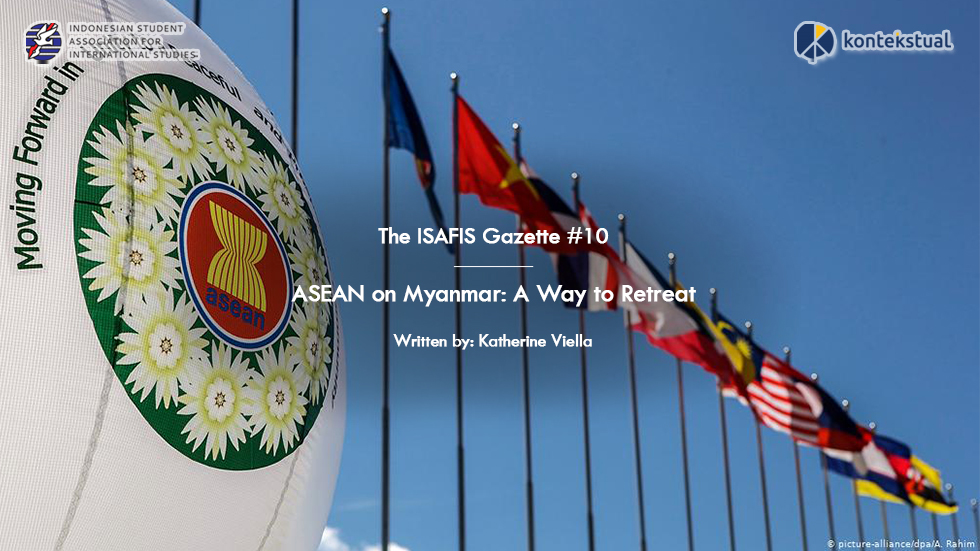ASEAN on Myanmar: A Way to Retreat

Illustration from ISAFIS
The clamorous turmoil happening in Myanmar for the past several months has been widely acknowledged by the international community. Yet, only a few profound steps have been hitherto taken. Despite the dissent voiced by the world, including Washington and London, the junta regime prevailing in Myanmar has continuously stood in a firm stance. Thus, it has come to light that ASEAN might be the key factor to Myanmar’s resolution – bringing the silver lining to the sinister crisis albeit the regional organisation has not exerted myriad efforts to prove that they could be one.
One must admit that the military regime has many strategies up their sleeves. For example, fifty-nine years after the 1962 Burmese coup d’état, Tatmadaw detained the democratically elected State Counsellor Aung San Suu Kyi, President Win Myint, and other leaders. Through this action, the Tatmadaw single handedly accused that the election won by the National League for Democracy was corrupt and took over the country’s power by putting them in detention. The accusation later became the ultimate ground of the coup executed by the military, claiming that the military has every right to seize power as the scandal may harm the country’s integrity. The hard-fought democracy has seemed to dissipate into thin air in a blink of an eye, prompting a series of protests on the streets. The military chief, Min Aung Hlaing, has ascended to power and only a few times did he appear to explain the country’s situation to the media. The whole country felt betrayed by the military who took the solemn oath to honour the constitution and unfortunately, did the exact opposite.
Regarding the crisis, as a regional organisation that it is, ASEAN has also attempted to seek solutions to solve the problem. And yet, the body itself has continuously been immersed in the dilemma of the members’ diverse notions and its own fundamental principles’ contradiction, starting from how ASEAN has been subtly divided into two polars. The first polar, consisting of Indonesia, Malaysia, and Singapore, firmly professed the step to endeavour the necessary means to resolve the crisis. Meanwhile, the second group of Thailand, Vietnam, Cambodia, and Laos, remains to hold onto the credo of non-interference. ASEAN has sternly emphasised its stance of no-ninterference from time to time to respect a country’s irrefragable sovereignty. Yet, the same ASEAN also commits to respecting fundamental freedoms, the promotion and protection of human rights, and the promotion of social justice. As contradictory as it may seem in Myanmar’s case, ASEAN then has decided to resort to its true ASEAN way.
On the 24th of April, two months after the coup, ASEAN finally held its first emergency meeting regarding Myanmar. Taking place in Jakarta, ASEAN gallantly invited the chief of the junta himself to the summit as the only representative of Myanmar, making the event heavily criticised, even referred to as “callous”. On the day when the ASEAN leaders spoke of law and came to terms with the final consensus, a total of 748 people were confirmed to have been murdered, 3,389 were under detention, and three were documented as fallen heroes (Assistance Association for Political Prisoners, 2021). The long-awaited meeting resulted in a five-point consensus that was considered scant to deal with Myanmar. The five points included (1) the call for an immediate cessation of violence, (2) a constructive dialogue among all parties, (3) a special envoy of the ASEAN Chair as a mediation of the dialogue process, (4) an acceptance of humanitarian aid by Myanmar, and (5) a visit to Myanmar by the special envoy and delegation. The paper, much to everybody’s disheartenment, neglected a few prominent matters to address, such as the release of political leaders currently held in detention. The solid fact of how ASEAN oddly left out the National Unity Government of Myanmar in the meeting ignited confusion among the public about the final paper, solely causing the meeting to look hazy and diffident. Even now in August, when it has already been months after the event, ASEAN has only reached the unanimity to appoint Erywan Yusof, the Second Minister of Foreign Affairs of Brunei Darussalam, as ASEAN’s official envoy to Myanmar. The thematic special envoy that is supposed to represent the entire body of ASEAN to Myanmar received a surfeit of predicaments, arising doubts whether the mere delegation of the envoy can suffice to resolve the mayhem.
As ASEAN faced a deadlock due to its internal discord, the situation in Myanmar was further exacerbated by the pandemic and the on-going riot. This can be seen from its national economy, with GDP growth expected to perch at -9.8% from 3.3%, inflation rate forecasted at 6.2% from 5.7%, and GDP growth rate forecasted at -10.6% from 2.4% in 2021 alone (Asian Development Bank, 2021). An important note to remember is that ASEAN is dealing with a junta and military regimes are “closed regimes” or “regimes of censorship or strong and unfettered secret services” (Hoffman, 2004, as cited in Jain, 2006). Thus, it is to be expected that the leader’s call for the cessation of violence won’t be compelled easily. Besides, if mere words matter, then the concatenation of vocables aired by the street protestors and foreign media would be the silver lining to the uproar since the very start. A plethora of non-ASEAN countries have considered prevailing an embargo or other sanctions to the junta as a measure to condemn the coup, quite the contrary from ASEAN who has continuously pursued the subtle way out.
With Aung San Suu Kyi and other democratic figures being held in detention, protests in Myanmar have been mostly spurred by the people’s self-consciousness. Yet, there is one X factor here: ASEAN’s existence. In 1997, when Burma departed from the British Empire and declined membership in the follow-on Commonwealth of Nations, it firmly decided to join ASEAN with high expectations that this membership would enhance both its international legitimacy and its economic progress (Guyot, 1998). ASEAN, being the X-factor, can turn the table to the people of Myanmar’s favour, ceasing the coup and turmoil and, most ultimately, restoring regional stability. ASEAN may have its firm grip stuck on the non-interference principle and highly respects national sovereignty, but the body must also consider the principles that outline the edifice of Responsibility to Protect (R2P), with a mental note that proactive actions are not necessarily violent. In tandem, ASEAN is capable of doing so many more actions to ameliorate the situation, instead of merely seizing months for a consensus paper and other months to send an envoy. Taking into account how gigantic conglomerates and corporations play roles behind supplying wherewithal of Myanmar’s military, economic sanctions and arms embargo are two things that have been professed on the table and might be worth a shot. There is a chance that the Tatmadaw would put up with them, as told by its deputy chief, Soe Win, regarding the international pressure. However, it’s dubious that Myanmar as a nation can thrive at all while living utterly in isolation.
Since the beginning of the crisis, ASEAN has obviously decided on its path by settling for the subtle ASEAN way, despite the public’s uproar that called for a proactive approach. The Myanmar crisis is ASEAN’s grandest obstacle, and how it muddles through will be an important event to note in the history of this regional body. The last scintilla of hope remains alive in everybody’s heart– that ASEAN can function itself to the utmost and be the important key role to ending the uprising in Myanmar. After all, it’s inherent in ASEAN’s principle itself that countries are united by a common desire and collective will to live in a region of lasting peace, security and stability while strengthening existing bonds of regional solidarity. Besides, we would not have the heart to simply watch and stand still as an entire nation collapses before our own eyes, would we?
References
Asian Development Bank. (2021, May 16). Myanmar: Economy. Asian Development Bank. Retrieved August 13, 2021, from https://www.adb.org/countries/myanmar/economy.
Assistance Association for Political Prisoners. (2021, April 24). Daily Briefing in Relation to the Military Coup. AAPP. Retrieved August 13, 2021, from https://aappb.org/?p=14567.
Association of Southeast Asian Nations. (2008, January). ASEAN Charter. The ASEAN Charter. Retrieved August 13, 2021, from https://asean.org/wp-content/uploads/images/archive/publications/ASEAN-Charter.pdf.
Guyot, J. (1998). Burma in 1997: From Empire to ASEAN. Asian Survey, 38(2), 190–195. https://doi.org/10.2307/2645678 Jain, B.M. (2006). Dynamics of Political Transition in Myanmar. Indian Journal of Asian Affairs, 19(2) 1–14. http://www.jstor.org/stable/41950472.
Katherine Viella is an International Relations undergraduate student at University of Indonesia. She is a staff of ISAFIS’ Research and Development Division.





